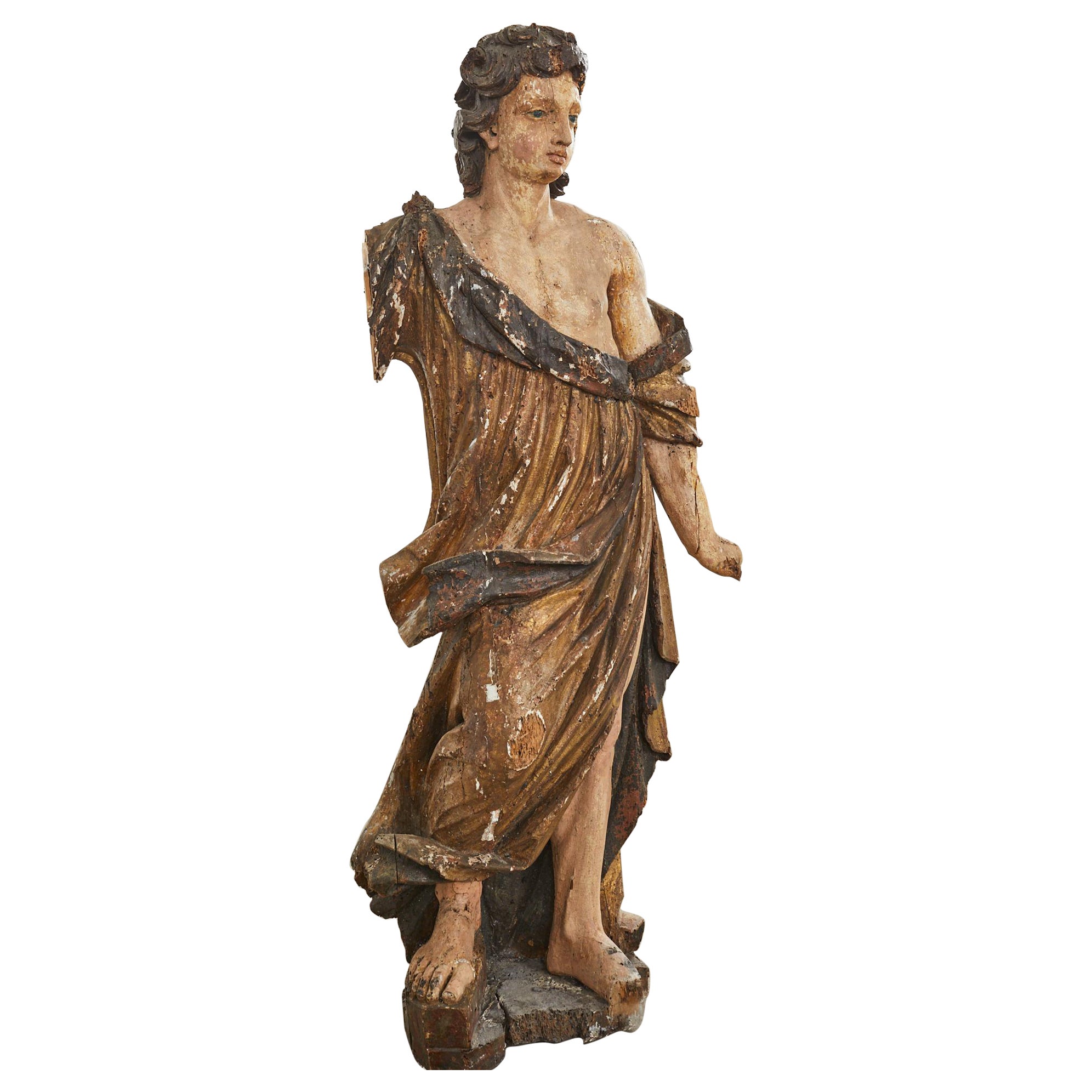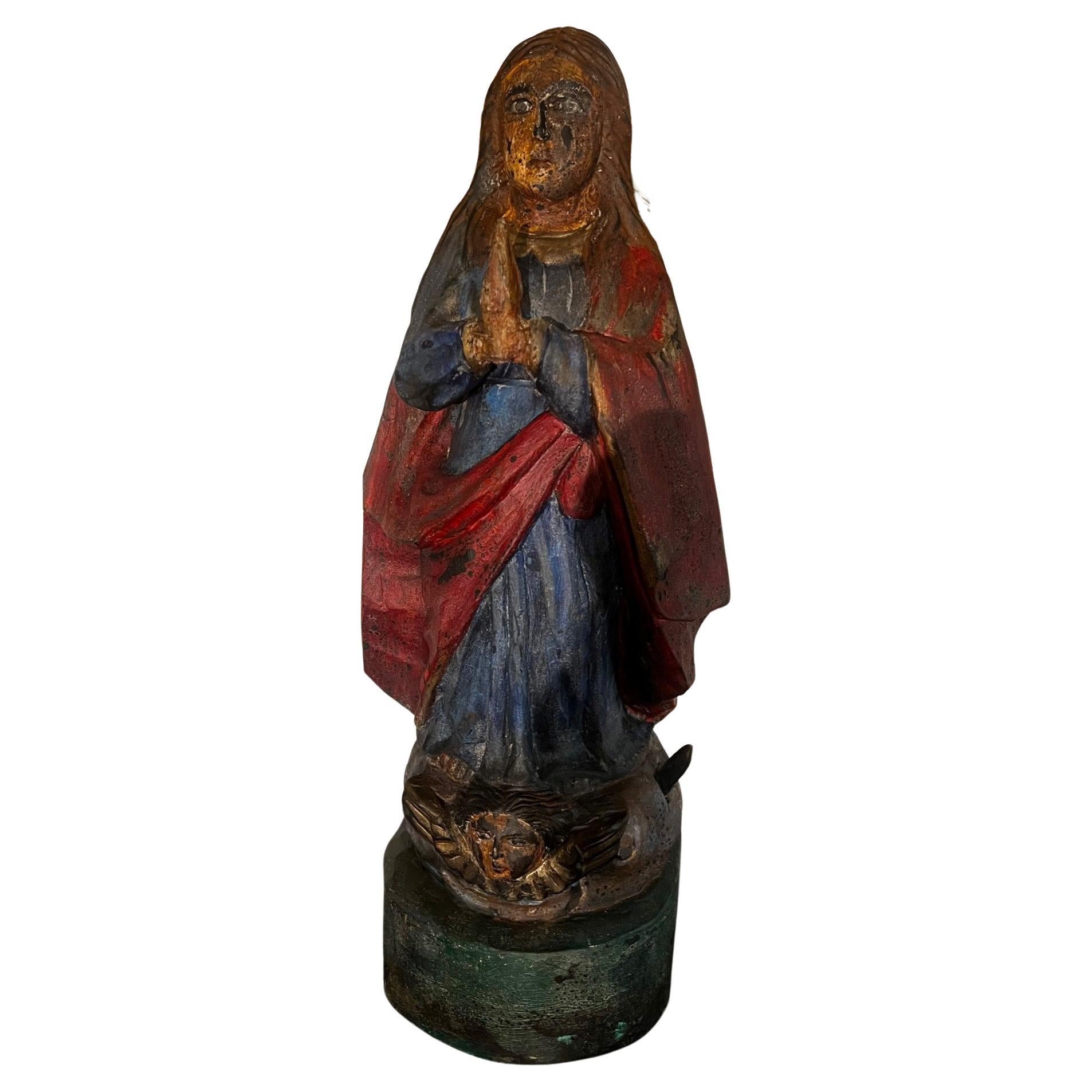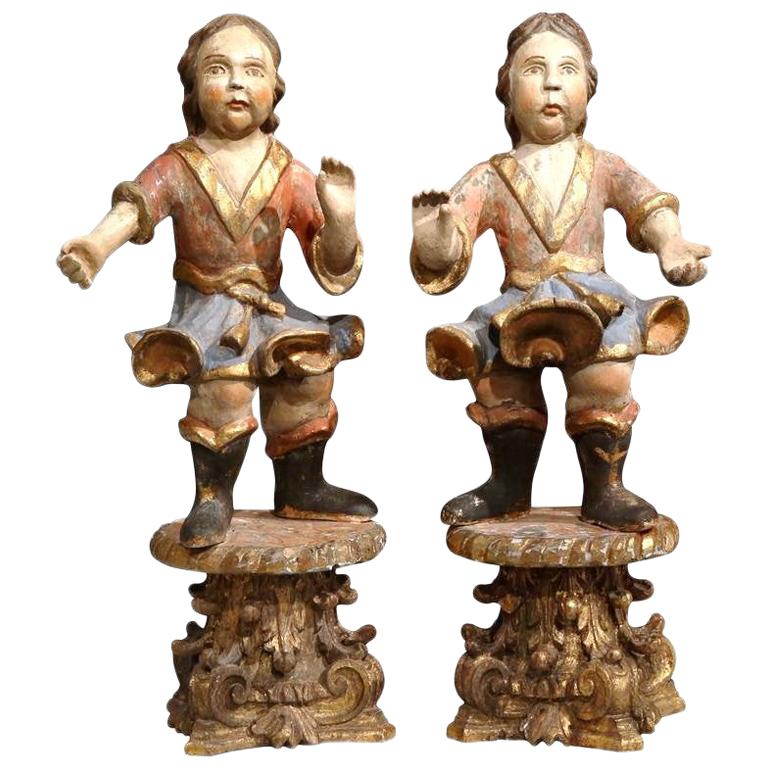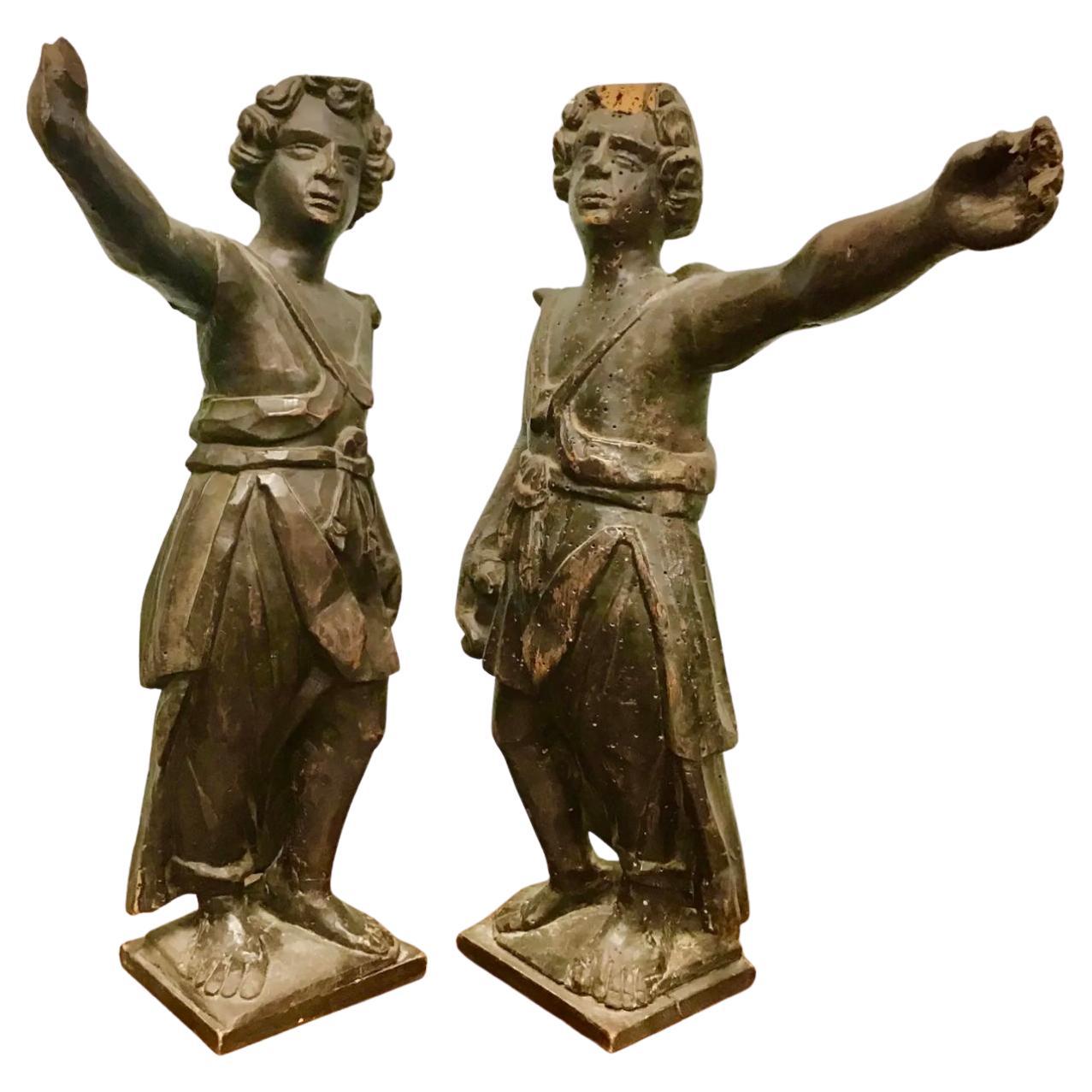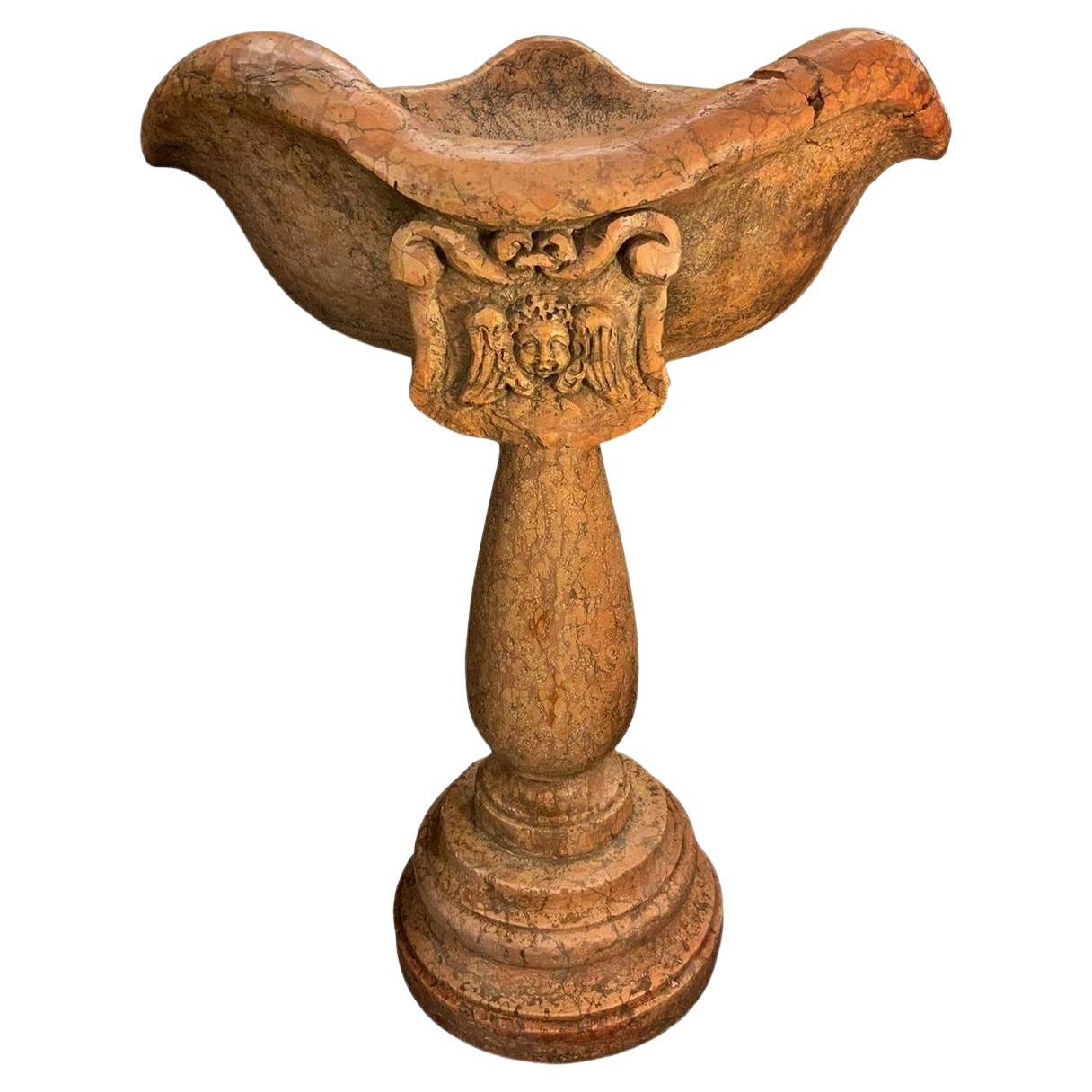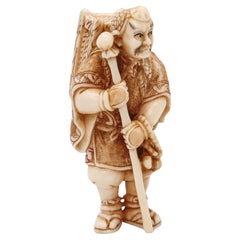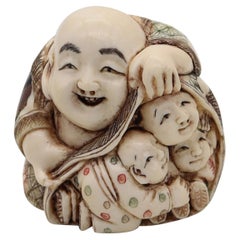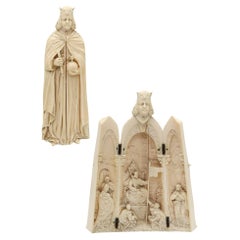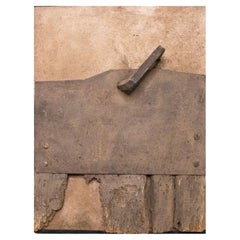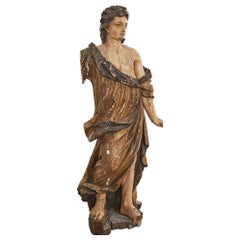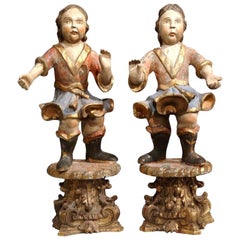Items Similar to Italy 18th Century Lombard Carved & Polychromate Sculpture of St Peter of Verona
Want more images or videos?
Request additional images or videos from the seller
1 of 9
Italy 18th Century Lombard Carved & Polychromate Sculpture of St Peter of Verona
About the Item
An Italian 18th century sculpture of St. Peter of Verona.
A magnificent sculpture of St Peter martyr of Verona, created by a member of the Lombard art school in Verona Italy, in the very early 18th century. The exquisite carving depicts the martyr saint standing, bearded and dressed as an archbishop, with very richly decorated ropes. St Peter show two wounds: one in the head and the other close to the heart. The sculpture is decorated with polychrome as black and gray, and the clothes are embellished with an absolutely fabulous, gilded work. Most probably this sculpture was part of a bigger scene or an altar and is actually mounted in a customized wood round base. In traditional iconography this martyr saint is usually depicted holding a large book in his left hand and a pen in his right. In the case of our piece, a compassionate and resigned image of his fatal fate is shown. Probably an image of his ascension to the heavens.
Pieces of art referring to this saint are very rare as it is a very particular religious and devotional art in Lombardy in the northeast of Italy. As a piece of 18th century Veronese-Lombardian art school is a unique opportunity to own.
St Peter of Verona
Peter of Verona (1205 – April 6, 1252), also known as Saint Peter Martyr and Saint Peter of Verona, was a 13th-century Italian Catholic priest. He was a Dominican friar and a celebrated preacher. He served as Inquisitor in Lombardy, was killed by an assassin, and was canonized as a Catholic saint 11 months after his death, making this the fastest canonization in history. Peter was born in the city of Verona into a family perhaps sympathetic to the Cathar heresy. Peter went to a Catholic school, and later to the University of Bologna, where he is said to have maintained his orthodoxy and, at the age of fifteen, met Dominic of Osma. Peter joined the Order of the Friars Preachers (Dominicans) and became a celebrated preacher throughout northern and central Italy. In his sermons he denounced heresy and also those Catholics who professed the Faith by words but acted contrary to it in deeds. Crowds came to meet him and followed him; conversions were numerous, including many Cathars who returned to the Catholic church. Because of this, a group of Milanese Cathars conspired to kill him. They hired an assassin, Carino of Balsamo. Carino's accomplice was Manfredo Clitoro of Giussano. On April 6, 1252, when Peter was returning from Como to Milan, the two assassins followed Peter to a lonely spot near Barlassina, and there killed him and mortally wounded his companion, a fellow friar named Domenico. Carino struck Peter's head with an axe and then attacked Domenico. Peter rose to his knees and recited the first article of the Apostles Creed. Offering his blood as a sacrifice to God, according to legend, he dipped his fingers in it and wrote on the ground: Credo in Deum, the first words of the creed. The blow that killed him cut off the top of his head, but the testimony given at the inquest into his death confirms that he began reciting the Creed when he was attacked. Domenico was carried to Meda, where he died five days afterwards.
Saint Peter the Martyr, Fra Angelico, 1438, altarpiece, Royal Collection, Hampton Court, London, United Kingdom, Ruth Pérez Buendía
Weight: 1,496.4 Grams, (1.49 Kg).
Measurements: 273 mm by 138 mm by 109 mm (10.75 x 5.45 x 4.28 Inches).
Note: This sculpture is an antique piece of art with around 300 years old.
Condition: The overall condition of this sculpture of St Peter of Verona is excellent. Beside the little normal wear, there is no damage, and all parts are secured in the settings. This piece has been carefully inspected to guarantee the condition and the authenticity.
INVENTORY REF: D041324AANM/.6734
- Attributed to:Veronese (Sculptor)
- Dimensions:Height: 10.75 in (27.31 cm)Width: 5.45 in (13.85 cm)Depth: 4.28 in (10.88 cm)
- Style:Baroque (Of the Period)
- Materials and Techniques:
- Place of Origin:
- Period:
- Date of Manufacture:1700
- Condition:Wear consistent with age and use. The overall condition of this sculpture of St Peter of Verona is excellent. Beside the little normal wear, there is no damage, and all parts are secured in the settings. This piece has been carefully inspected to guarantee the authenticity.
- Seller Location:Miami, FL
- Reference Number:Seller: D041324AANM/.67341stDibs: LU8303239264692
About the Seller
5.0
Gold Seller
These expertly vetted sellers are highly rated and consistently exceed customer expectations.
1stDibs seller since 2023
94 sales on 1stDibs
Typical response time: <1 hour
- ShippingRetrieving quote...Ships From: Miami, FL
- Return PolicyA return for this item may be initiated within 1 day of delivery.
Authenticity Guarantee
In the unlikely event there’s an issue with an item’s authenticity, contact us within 1 year for a full refund. DetailsMoney-Back Guarantee
If your item is not as described, is damaged in transit, or does not arrive, contact us within 7 days for a full refund. Details24-Hour Cancellation
You have a 24-hour grace period in which to reconsider your purchase, with no questions asked.Vetted Professional Sellers
Our world-class sellers must adhere to strict standards for service and quality, maintaining the integrity of our listings.Price-Match Guarantee
If you find that a seller listed the same item for a lower price elsewhere, we’ll match it.Trusted Global Delivery
Our best-in-class carrier network provides specialized shipping options worldwide, including custom delivery.More From This Seller
View AllJAPAN 1890 Meiji Polychromate Netsuke Of a Yamabushi Carved In Ivory
Located in Miami, FL
Japanese Meiji period netsuke. of a Yamabushi.
This is an exceedingly beautiful and intricate carved netsuke, created during the imperial Japan in the Meiji period, back in he 1890....
Category
Antique 1890s Japanese Meiji Antiquities
Materials
Ivory
$1,012 Sale Price
25% Off
JAPAN 1910 Meiji Polychromate Netsuke of Hotei Carved In Ivory
Located in Miami, FL
Japanese Meiji period netsuke of Hotei.
This is an exceedingly beautiful netsuke, created during the imperial Japan in the Meiji period, back in he 1910. The netsuke has been carefu...
Category
Vintage 1910s Japanese Meiji Sculptures and Carvings
Materials
Ivory
Flemish 1850 Carved Sculpture Triptych of Emperor Charlemagne Enthroned
By Flemish
Located in Miami, FL
A carved triptych of emperor Charlemagne.
Beautiful triptych sculpture from Flemish origin made in the second quarter 19th Century, circa 1850. It was...
Category
Antique Mid-19th Century Belgian Gothic Revival Figurative Sculptures
Materials
Brass
$2,248 Sale Price
25% Off
Ferruccio Bortoluzzi Italian 1964 Composizioni #75 Concretism Post War Sculpture
By Ferruccio Bortoluzzi
Located in Miami, FL
Post war sculptural art created by Ferruccio Bortoluzzi.
A concretism post war piece of art, created by the Italian artist Ferruccio Bortoluzzi, back in the 1964. This three-dimensi...
Category
Vintage 1960s Italian Mid-Century Modern Abstract Sculptures
Materials
Iron
$6,375 Sale Price
25% Off
Ferruccio Bortoluzzi Italian 1962 Composizioni 24 Concretism Post War Sculpture
By Ferruccio Bortoluzzi
Located in Miami, FL
Post war sculptural art created by Ferruccio Bortoluzzi (1920-2007).
A concretism post war piece of art, created by the Italian artist Ferruccio Bortoluzzi, back in the 1962. This t...
Category
Vintage 1960s Italian Mid-Century Modern Abstract Sculptures
Materials
Iron
$20,988 Sale Price
25% Off
French 1900 Edwardian Faux Tortoise Parasol Handle in 18kt Gold & Carved Citrine
Located in Miami, FL
Edwardian parasol handle made in France.
Very beautiful and elegant piece, created in Paris France during the Edwardian and Belle Epoque periods, back in the 1900. This fabulous p...
Category
Antique Early 1900s French Edwardian Desk Sets
Materials
Quartz, Gold
$2,587 Sale Price
25% Off
You May Also Like
18th Century Italian Baroque Carved Santos Icon Sculpture
Located in Rio Vista, CA
Majestic 18th century Italian baroque polychrome Santos icon sculpture of a young man. The carved icon is depicted standing and wearing a flowing robe with graceful movement. He has ...
Category
Antique 18th Century Italian Baroque Figurative Sculptures
Materials
Wood
18th Century Italian Carved Santo Boy Sculpture Icon
Located in Rio Vista, CA
Large 18th century Italian carved Santo figural icon sculpture depicting a boy with arms raised dressed in a blue parcel-gilt outfit with boots. Heavily aged and distressed polychrom...
Category
Antique 18th Century Italian Baroque Figurative Sculptures
Materials
Glass, Lacquer, Giltwood, Wood
18th Century Italian Carved Wood Polychrome Virgin Mary Sculpture
Located in Doha, QA
This is an outstanding Italian 18th century carved wood polychromed sculpture of Virgin Mary. The Sculpture is hand painted with some remains of a gold gilt in few places and originated until lately in a private Villa in Tuscany (Italy). The colors are typical red, blue and green are spectacular on this large figure. The Virgin's hands are joined together in a prayer, while standing on a pedestal on the both sides of which are devil's horns (bottom left side horn missing ) symbolising Holly Mary defeating the Evil, protected by the Holly Ghost and an Angel. A story tells the pose of the Virgin Mary sculpture...
Category
Antique 18th Century Italian Baroque Figurative Sculptures
Materials
Wood, Pine
Pair of 18th Century Italian Carved Polychrome and Gilt Cherub Sculptures
Located in Dallas, TX
Place this beautiful pair of antique carved figurines on a mantel or a console. Crafted in Italy, circa 1780, the tall sculptures depict two chubby cherubs standing on carved gilt ba...
Category
Antique Late 18th Century Italian Baroque Figurative Sculptures
Materials
Gold Leaf
18th Century Italian Carved Wood Sculptures, a Pair
Located in Bradenton, FL
Beautiful pair of antique carved figurines. Italian, circa 1780, the tall sculptures depict two men, probably soldiers, in flowing robes with one arm out stretched.
The elegant fig...
Category
Antique 18th Century Italian Neoclassical Figurative Sculptures
Materials
Wood
Italian Holy Water Stoup in Red Verona Marble 18th Century
By Europa Antiques
Located in Madrid, ES
Italian Holy Water Stoup in Red Verona Marble 18th Century
Dimensions:
h 112 cm x 75 cm x 75 cm
With front frieze depicting an angel
very good c...
Category
Antique 18th Century Italian Baroque Figurative Sculptures
Materials
Marble
Recently Viewed
View AllMore Ways To Browse
Antique Words
Hand Carved Ivory
Antique Catholic
Heart Carved Wood
13th Century Italy
Late 18th Century Dress
Antique Religious Book
Large Religious Sculpture
Heaven Antique Furniture
Antique 18th Century Dress
Antique Italian Altar
Antique Wood Carved Roses
Wood Priest
Church Carving
Catholic Saint
Catholic Church Furniture
Italian Lombard
Used Catholic Church Furniture
